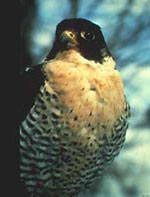A couple of weeks ago, while the federal government was removing peregrine falcons from the list of endangered species, I was out watching the first monarch butterflies migrate through the desert on their way to Mexico. I saw both the migratory monarchs and their homebody cousins, the butterflies known as Queens, hovering around the lovely flowers of a milkweed native to Western farmlands and ranchlands. And I listened to the radio as Interior Secretary Bruce Babbitt recounted the story of how peregrines bounced back from the brink of extinction, thanks to the banning of the pesticide DDT and the enforcement of the Endangered Species Act.

Peregrine falcon, happy and DDT-free.
I felt a certain elation at hearing that there are now more than 1,600 pairs of DDT-free peregrines. At the same time, I realized that endangered butterflies face threats similar to what peregrines faced in the 1960s, before DDT was banned. One threat is a toxin that can be found in the pollen of new varieties of corn. This toxin can kill the caterpillars of butterflies, including six federally listed endangered species as well as the monarch (whose spectacular migration is considered an endangered phenomenon), when they feed upon milkweed plants at the edge of blooming corn fields.
The toxic pollen comes from several new genetically engineered crops known as BT corn, planted this summer on more than 20 million acres in America’s heartland. The agrochemical industry claims that BT corn can save farmers from suffering losses caused by several crop pests, including the European and Southwestern corn borers. But though BT corn is temporarily effective in repelling these pests, it does so at a high price to both farmers and wildlife.
You wouldn’t know that from listening to the agrochemical industry. When scientists from Cornell University first confirmed that BT corn poses a real threat to monarchs and other imperiled butterflies this spring, the industry responded in much the same way it did when Rachel Carson shouted the first warning cries about DDT. It claimed that lab studies had little significance in the real world and that monarch caterpillars would hardly be exposed to the BT corn toxins because most milkweeds do not grow in or near cornfields.

Pollinating pals.
On a recent trip to St. Louis, I wondered if the industry’s publicists who live there ever go outside. Over a 150-mile stretch between Chicago and St. Louis, I saw 45 miles of cornfields where milkweeds were extremely common within 10 feet of the corn itself. At least along this one corridor frequented by migratory Monarchs, caterpillars can be easily exposed to the toxic pollen raining down on them.
The agrochemical industry has also tried to discredit the scientists’ report, which was published in Nature magazine, as sloppy work. Curiously, it then attempted to hire some of the same scientists who published the report, announcing that it took concerns about monarchs seriously. At the same time, biotechnology advocates whined that BT corn was being given a bum rap: Toxic BT corn pollen kills far fewer monarchs than what pesticides would kill if BT corn were not available, they said. But to date, there is no indication that the presence of BT corn in the field corn market has markedly reduced the total amount of pesticides being dowsed on field corn. It is agribusiness as usual down on the corporate farm.
The EPA should have consulted with the U.S. Fish and Wildlife Service long before permitting Monsanto and Novartis to release BT corn for planting on millions of acres. Now that the cat is out of the bag, the EPA and the U.S. Department of Agriculture should at least conduct their own field studies of BT corn’s effects on endangered butterflies. But they continue to stonewall, saying they are waiting for the agrochemical industry’s proprietary studies of BT corn and monarchs before they announce any policy changes. As one Fish and Wildlife Service employee anonymously warned, the EPA is letting the wolves tend the hen house.
Crops genetically engineered to produce toxins require as much scrutiny as do other kinds of pesticides, especially when some of the non-target organisms exposed to them are federally protected. The EPA must be urged to suspend permits for BT corn until it can show that the crops do not pose additional risks to endangered butterflies.
I’m glad the peregrine falcon has soared off the endangered species list. Now let’s help our magnificent pollinators do the same.

